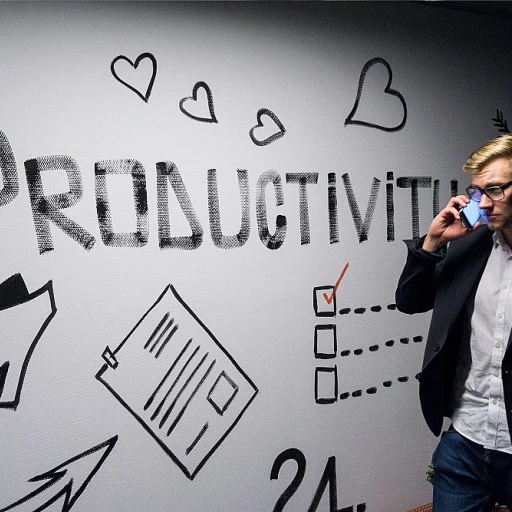
Understanding the Skills Gap
Defining the Skills Gap: A Modern Challenge
In today's rapidly evolving business landscape, the skills gap has emerged as a prominent challenge for leaders and organizations across various industries. The term skills gap refers to the difference between the skills employers need and the skills that employees currently possess. This gap has significant implications for performance, productivity, and overall business success.
Impact on Business
Organizations that fail to address the skills gap risk facing challenges in maintaining a competitive edge. The gap can affect various areas, including employee morale, company culture, and work environment. Leaders and management teams must understand how these gaps can impact strategic planning and business objectives.
The Role of Training and Development
Addressing the skills gap requires a focus on leadership development and ongoing training. By doing so, companies can cultivate essential skills such as strategic thinking, communication skills, and emotional intelligence. These skills are crucial in preparing employees for effective leadership roles and decision making.
Leadership Topics for Skills Enhancement
- Developing leadership skills through structured leadership training programs.
- Implementing conflict resolution and problem solving training for teams.
- Emphasizing soft skills and their importance in team building and change management.
Exploring these top leadership topics can help bridge the skills gap, fostering an environment of growth and innovation. For more insights on addressing the gap, you may want to read about effective mentorship programs as part of skills development strategies.
The Role of Leadership in Bridging the Gap
The Impact of Effective Leadership in Skill Bridging
The skills gap presents a considerable challenge that demands effective leadership to successfully bridge. In navigating this complex landscape, leaders play a pivotal role in shaping organizational strategies that foster skill development and adaptability among team members. A leader’s ability to inspire, empower, and direct teams towards cohesive goals directly impacts the effectiveness of closing the skills gap.
Building a Culture of Learning and Development
Emphasizing a culture of continuous learning is essential. Leaders must prioritize fostering environments where skill-enhancing opportunities are accessible and actively encouraged. This reflects in strategic planning for leadership development training topics that encompass both technical and soft skills, enabling teams to adapt to change and innovate.
Promoting Strategic Decision Making
Effective leadership often requires strategic decision making that aligns business goals with workforce development. Leaders need to assess skill deficiencies within their teams and identify training needs that align with organizational objectives. By doing so, they not only enhance team performance but also ensure that the workforce can navigate evolving work environments.
Harnessing Diverse Leadership Styles
Diverse leadership styles can address various aspects of the skills gap. Adaptive leaders who practice emotional intelligence and communication skills can better understand and respond to their teams’ development needs. Additionally, the integration of leadership styles that encourage problem solving and conflict resolution can facilitate a more resilient and adaptable organization capable of absorbing and implementing change effectively.
Leadership Strategies for Workforce Development
Strategies for Skill Development and Workforce Enhancement
Leadership plays a pivotal role in workforce development, tackling the skills gap head-on. An effective leader knows that investing in team training and development results in a more proficient workforce. Here are some strategies to enhance skill building and improve team performance.- Leadership Training Focus: Implementing targeted leadership training topics like emotional intelligence and conflict resolution is crucial. This not only enhances individual skills but positively transforms the work environment.
- Flexible Learning Opportunities: Foster a culture of continuous learning by providing access to various training formats: workshops, e-learning platforms, and on-the-job training.
- Encouraging Soft Skills Development: In addition to technical skills, leaders should emphasize the significance of soft skills such as communication and problem-solving. This hands-on approach can effectively bridge the skills gap.
- Tailored Leadership Styles: Adapt leadership styles to suit individual team members and their unique challenges. The personalized approach can significantly boost team motivation and engagement.
- Strategic Planning and Decision Making: Help employees engage in strategic thinking and time management tasks. These skills are essential for overcoming rapid changes in the business landscape, aligning with long-term goals.
- Promote Cross-Department Collaboration: By promoting collaboration across different business sectors, leaders can enhance a mutual exchange of knowledge — a key step in addressing the skills gap.
Innovative Approaches to Skill Building
New Horizons in Skill Acquisition
In the rapidly changing business landscape, staying ahead of the skills gap requires organizations to embrace innovative approaches to skill building. Leaders must foster a culture of continuous learning and development to ensure their teams remain competitive and adaptable.Transformative Learning and Development Techniques
Understanding that traditional training methods may no longer suffice, leaders are shifting towards more immersive and interactive training experiences. Incorporating technology, such as virtual reality and gamified learning platforms, allows team members to engage deeply and learn more effectively. These approaches not only boost skill acquisition but also enhance emotional intelligence and problem solving abilities.Cultivating a Growth-Oriented Work Environment
Creating an environment where continuous learning is valued is crucial. Leaders should encourage open communication and feedback, allowing team members to share knowledge and experiences. By promoting soft skills development alongside technical skill sets, leaders aid employees in becoming more well-rounded professionals.Strategic Partnerships for Skill Development
Forming alliances with educational institutions and industry experts can also provide a significant advantage in bridging the skills gap. Such partnerships can offer critical insights into emerging trends and training topics, helping organizations tailor their development programs to align with industry demands.Integrating Leadership Styles for Success
An effective leadership style that incorporates elements of strategic thinking, time management, and conflict resolution can lead to a more adaptable and capable workforce. By embracing a model of leadership that supports change management, leaders empower their teams to navigate and thrive amidst uncertainty. Innovative approaches to skill building are integral to closing the skills gap, and ultimately, leaders have the responsibility to spearhead these initiatives. By investing in the development of their teams, leaders ensure sustained growth and business success.Measuring Success in Closing the Skills Gap
Evaluating Success in Tackling Skill Discrepancies
Effectively bridging the skills gap becomes a paramount concern for leaders as they steer their teams towards growth and development. Measuring success in closing this gap involves a multi-faceted approach, ensuring the strategies implemented are both impactful and sustainable. Here are some critical components to consider:
- Performance Metrics: Establishing clear performance indicators is essential. Leaders should define what success looks like in their work environment by setting benchmarks and targets based on strategic planning and management objectives. These metrics should not only focus on quantitative outputs such as productivity but also qualitative improvements in soft skills and emotional intelligence.
- Employee Feedback: Garnering feedback from team members is invaluable. Leaders need to create a culture of open communication where employees feel comfortable sharing their insights on training topics and skill-building programs. Regular surveys and feedback sessions can highlight areas of success and opportunities for further development.
- Progress in Leadership Development: Tracking advancements in leadership skills is another critical parameter. This includes improvements in strategic thinking, problem solving, and effective leadership styles. Observing how these changes influence decision making and conflict resolution can offer a clearer picture of how effectively leadership training is being applied across teams.
- Team Performance: Evaluate how well teams are collaborating and whether their strategic goals align with business objectives. Analyzing the increase in team efficiency and the quality of collaborative efforts can highlight successful leadership strategies and skill-building initiatives.
- Adapting to Change: Assess the adaptability of teams and leaders to change management challenges. An organization's ability to respond to industry shifts is a crucial measure of its preparedness and response to skills gaps. Effective change management facilitates smoother transitions, fostering a more resilient and agile workforce.
- Behavioral Changes: Observing changes in workplace culture and employee attitudes toward learning and development can indicate progress. Encouraging a mindset of continuous improvement among employees is an integral part of the leadership journey, aligning with broader organizational goals.
By focusing on these aspects, leaders can not only measure the effectiveness of their efforts in closing the skills gap but also fine-tune leadership development initiatives to meet evolving needs. This ongoing assessment will ensure teams are well-equipped to handle future trends and challenges, nurturing a robust, dynamic business environment.
Future Trends in Leadership and Skills Development
Emerging Trends in Leadership and Skill Development
The ever-evolving landscape of work necessitates continuous adaptation in leadership and skill development. As businesses strive to remain competitive, leaders must anticipate and respond to emerging trends. Understanding these trends can help organizations prepare for the future and effectively address the skills gap.- Technology Integration: As technology advances at a rapid pace, leaders must prioritize digital literacy within their teams. Training programs that incorporate new technologies can enhance efficiency and innovation, ensuring teams remain at the forefront of industry developments.
- Personalized Learning: Customizing training programs to cater to individual learning styles and skill levels allows employees to optimize their learning experiences. Personalized learning paths empower team members and enhance their engagement, leading to improved performance.
- Emphasis on Soft Skills: While technical skills remain crucial, soft skills such as communication, emotional intelligence, and problem solving are equally important. Training programs that focus on these areas can improve team dynamics and foster an inclusive work environment.
- Flexible Leadership Styles: Modern leaders must adapt their management styles to suit diverse teams and varied work environments. Embracing flexibility in leadership styles can lead to more effective decision making and improve overall team performance.
- Strategic Succession Planning: Preparing the next generation of leaders is essential for sustaining long-term business success. Effective succession planning ensures a smooth transition as experienced leaders retire or move on, and maintains continuity in leadership vision.
- Focus on Diversity and Inclusion: Creating a diverse and inclusive culture is imperative for effective leadership. Diverse teams bring varied perspectives that can drive innovation and enhance problem-solving capabilities.
- Cross-Industry Collaboration: Engaging with different industries can offer fresh perspectives and insights. Leaders can benefit from partnerships and learn from best practices in other sectors.












